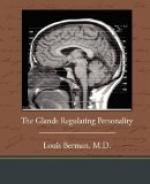He was active, practical and eminently successful. His wife recalls Florence Nightingale, in face, figure and conduct (people who are built alike as regards their internal secretions are those whom we recognize as similar physically and psychically). She, too, was a pituito-adrenal, and in so far resembled her husband. But as in a woman ante-pituitary and adrenal superiority make for masculinity, she must be classed as a masculinoid type of woman. She was socially aggressive, and took part in the revolutionary movement of her time in Ireland. Thus we find that Oscar Wilde was the result of a mating of internal secretions acting in the same direction. The process might be compared to parthenogenesis.
It is on record that when enceinte his mother often expressed the wish that her child be a girl. When a boy was born, she was immensely disappointed. To compensate for her disappointment, she brought him up a good deal like a little girl. She had him dressed in girls’ clothes at an age when most boys are violent destroyers of clothing. She would hang massive jewelry upon him, for the delight of playing with the resultant stage picture as a satisfaction for her discontented desires. In the light of modern psychology, and our formulization of her endocrine status, we must put down her conduct to a suppressed homosexual craving. Had her son been built along the lines of strong emphatic masculinity, her influence, though vicious, would probably have found no congenial soil, and would have died out altogether after his contacts with the outer world, beginning with school. No matter how she would have conditioned his vegetative system temporarily, his internal secretions, released then from compression, would have asserted themselves and determined his fate differently. However, it is quite possible that if such had been the case Oscar Wilde, the aesthete, the paradoxer, the disciple of Walter Pater and Baudelaire, would have stayed in the land of the to be born. I mean that then we would not have had Oscar Wilde, but another person, genius or commonplace, who also might have borne the name of Oscar Wilde.
That was not to be. The singular assortment of endocrines that mingled their activities to make Oscar Wilde shaped a personality which we must classify as the thymocentric (thymus-centered). Why this should be so is an interesting question. Pituito-adrenal plus pituito-adrenal of his heredity should make two pituito-adrenals according to elementary arithmetic and the rule of three. A cancellation of the two factors of the equation rather than addition seems to have occurred. The result was a persistent thymus superiority, with an instability of the other two main glands involved.




